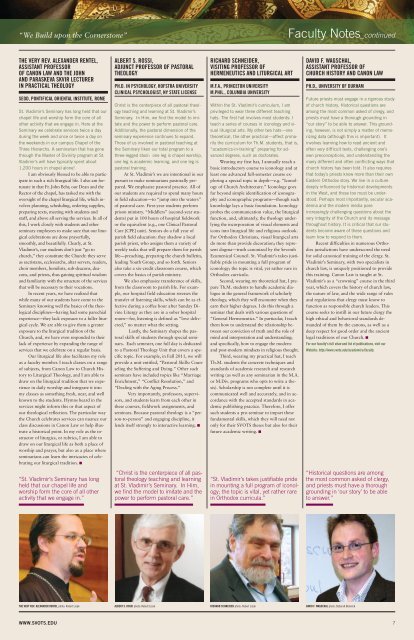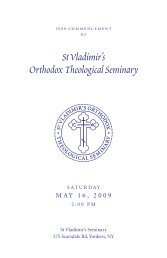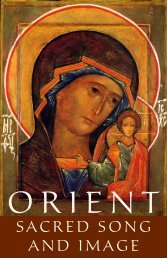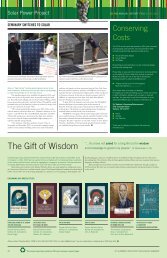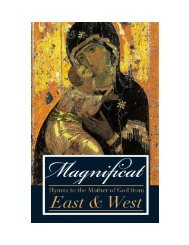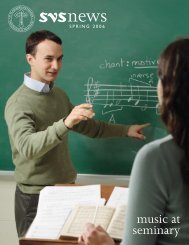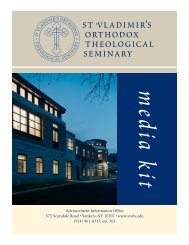THE SVS VINE
Annual Report FY11 - St Vladimir's Orthodox Theological Seminary
Annual Report FY11 - St Vladimir's Orthodox Theological Seminary
- No tags were found...
You also want an ePaper? Increase the reach of your titles
YUMPU automatically turns print PDFs into web optimized ePapers that Google loves.
“We Build upon the Cornerstone”<br />
Faculty Notes_continued<br />
<strong>THE</strong> VERY REV. ALEXANDER RENTEL,<br />
ASSISTANT PROFESSOR<br />
OF CANON LAW AND <strong>THE</strong> JOHN<br />
AND PARASKEVA SKVIR LECTURER<br />
IN PRACTICAL <strong>THE</strong>OLOGY<br />
SEOD, PONTIFICAL ORIENTAL INSTITUTE, ROME<br />
St. Vladimir’s Seminary has long held that our<br />
chapel life and worship form the core of all<br />
other activity that we engage in. Here at the<br />
Seminary we celebrate services twice a day<br />
during the week and once or twice a day on<br />
the weekends in our campus Chapel of the<br />
Three Hierarchs. A seminarian that has gone<br />
through the Master of Divinity program at St.<br />
Vladimir’s will have typically spent about<br />
1,200 hours in chapel alone!<br />
I am obviously blessed to be able to participate<br />
in such a rich liturgical life. I also am fortunate<br />
in that Fr. John Behr, our Dean and the<br />
Rector of the chapel, has tasked me with the<br />
oversight of the chapel liturgical life, which involves<br />
planning, scheduling, ordering supplies,<br />
preparing texts, meeting with students and<br />
staff, and above all serving the services. In all of<br />
this, I work closely with students and other<br />
seminary employees to make sure that our liturgical<br />
celebrations are done prayerfully,<br />
smoothly, and beautifully. Clearly, at St.<br />
Vladimir’s, our students don’t just “go to<br />
church,” they constitute the Church: they serve<br />
as sacristans, ecclesiarchs, altar servers, readers,<br />
choir members, homilists, sub-deacons, deacons,<br />
and priests, thus gaining spiritual wisdom<br />
and familiarity with the structure of the services<br />
that will be necessary to their vocations.<br />
In recent years, we have realized that<br />
while many of our students have come to the<br />
Seminary knowing well the basics of the theological<br />
disciplines—having had some parochial<br />
experience—they lack exposure to a fuller liturgical<br />
cycle. We are able to give them a greater<br />
exposure to the liturgical tradition of the<br />
Church, and, we have even responded to their<br />
lack of experience by expanding the range of<br />
services that we celebrate on a regular basis.<br />
Our liturgical life also facilitates my role<br />
as a faculty member. I teach classes on a range<br />
of subjects, from Canon Law to Church History<br />
to Liturgical Theology, and I am able to<br />
draw on the liturgical tradition that we experience<br />
in daily worship and integrate it into<br />
my classes as something fresh, near, and well<br />
known to the students. Hymns heard in the<br />
services might inform this or that aspect of<br />
our theological reflection. The particular way<br />
the Church celebrates services can nuance our<br />
class discussions in Canon Law or help illustrate<br />
a historical point. In my role as the instructor<br />
of liturgics, or rubrics, I am able to<br />
draw on our liturgical life as both a place of<br />
worship and prayer, but also as a place where<br />
seminarians can learn the intricacies of celebrating<br />
our liturgical tradition. ■<br />
ALBERT S. ROSSI,<br />
ADJUNCT PROFESSOR OF PASTORAL<br />
<strong>THE</strong>OLOGY<br />
PH.D. IN PSYCHOLOGY, HOFSTRA UNIVERSITY<br />
CLINICAL PSYCHOLOGIST, NY STATE LICENSE<br />
Christ is the centerpiece of all pastoral theology<br />
teaching and learning at St. Vladimir’s<br />
Seminary. In Him, we find the model to imitate<br />
and the power to perform pastoral care.<br />
Additionally, the pastoral dimension of the<br />
seminary experience continues to expand.<br />
Those of us involved in pastoral teaching at<br />
the Seminary liken our total program to a<br />
three-legged stool: one leg is chapel worship,<br />
one leg is academic learning, and one leg is<br />
pastoral training.<br />
At St. Vladimir’s we are intentional in our<br />
pursuit to make seminarians pastorally prepared.<br />
We emphasize pastoral practice. All of<br />
our students are required to spend many hours<br />
in field education—to “jump into the waters”<br />
of pastoral care. First-year students perform<br />
prison ministry. “Middlers” (second-year students)<br />
put in 100 hours of hospital fieldwork<br />
or the equivalent (e.g., one Clinical Pastoral<br />
Care [CPE] unit). Seniors do a full year of<br />
parish field education: they shadow a local<br />
parish priest, who assigns them a variety of<br />
weekly tasks that will prepare them for parish<br />
life—preaching, preparing the church bulletin,<br />
leading Youth Group, and so forth. Seniors<br />
also take a six-credit classroom course, which<br />
covers the basics of parish ministry.<br />
We also emphasize transference of skills,<br />
from the classroom to parish life. For example,<br />
our hospital field education stresses the<br />
transfer of listening skills, which can be as effective<br />
during a coffee hour after Sunday Divine<br />
Liturgy as they are in a sober hospital<br />
room—for, listening is defined as “love delivered,”<br />
no matter what the setting.<br />
Lastly, the Seminary shapes the pastoral<br />
skills of students through special seminars.<br />
Each semester, one full day is dedicated<br />
to a Pastoral Theology Unit that covers a specific<br />
topic. For example, in Fall 2011, we will<br />
provide a unit entitled, “Pastoral Skills: Counseling<br />
the Suffering and Dying.” Other such<br />
seminars have included topics like “Marriage<br />
Enrichment,” “Conflict Resolution,” and<br />
“Dealing with the Aging Process.”<br />
Very importantly, professors, supervisors,<br />
and students learn from each other in<br />
these courses, fieldwork assignments, and<br />
seminars. Because pastoral theology is a “person-to-person”<br />
and engaging discipline, it<br />
lends itself strongly to interactive learning. ■<br />
RICHARD SCHNEIDER,<br />
VISITING PROFESSOR OF<br />
HERMENEUTICS AND LITURGICAL ART<br />
M.F.A., PRINCETON UNIVERSITY<br />
M.PHIL., COLUMBIA UNIVERSITY<br />
Within the St. Vladimir’s curriculum, I am<br />
privileged to wear three different teaching<br />
hats. The first hat involves most students: I<br />
teach a series of courses in iconology and visual<br />
liturgical arts. My other two hats—one<br />
theoretical, the other practical—affect primarily<br />
the curriculum for Th.M. students, that is,<br />
“academics-in-training” preparing for advanced<br />
degrees, such as doctorates.<br />
Wearing my first hat, I annually teach a<br />
basic introductory course to iconology and at<br />
least one advanced full-semester course exploring<br />
a special topic in depth—e.g. “Iconology<br />
of Church Architecture.” Iconology goes<br />
far beyond simple identification of iconography<br />
and iconographic programs—though such<br />
knowledge lays a basic foundation. Iconology<br />
probes the communication value, the liturgical<br />
function, and, ultimately, the theology underlying<br />
the incorporation of visual elements and<br />
icons into liturgical life and religious outlook.<br />
For Orthodox Christians, visual liturgical arts<br />
do more than provide decoration; they represent<br />
dogma—truth canonized by the Seventh<br />
Ecumenical Council. St. Vladimir’s takes justifiable<br />
pride in mounting a full program of<br />
iconology; the topic is vital, yet rather rare in<br />
Orthodox curricula.<br />
Second, wearing my theoretical hat, I prepare<br />
Th.M. students to handle academic dialogue<br />
in the general framework of scholarly<br />
theology, which they will encounter when they<br />
earn their higher degrees. I do this through a<br />
seminar that deals with various questions of<br />
“General Hermeneutics.” In particular, I teach<br />
them how to understand the relationship between<br />
our conviction of truth and the role of<br />
mind and interpretation and understanding;<br />
and specifically, how to engage the modernand<br />
post-modern mindsets in religious thought.<br />
Third, wearing my practical hat, I teach<br />
Th.M. students the concrete techniques and<br />
standards of academic research and research<br />
writing (as well as any seminarian in the M.A.<br />
or M.Div. programs who opts to write a thesis).<br />
Scholarship is not complete until it is<br />
communicated well and accurately, and in accordance<br />
with the accepted standards in academic<br />
publishing practice. Therefore, I offer<br />
such students a pro-seminar to impart these<br />
fundamental skills, which they will need not<br />
only for their SVOTS theses but also for their<br />
future academic writing. ■<br />
DAVID F. WAGSCHAL,<br />
ASSISTANT PROFESSOR OF<br />
CHURCH HISTORY AND CANON LAW<br />
PH.D., UNIVERSITY OF DURHAM<br />
Future priests must engage in a rigorous study<br />
of church history. Historical questions are<br />
among the most common asked of clergy, and<br />
priests must have a thorough grounding in<br />
“our story” to be able to answer. This grounding,<br />
however, is not simply a matter of memorizing<br />
data (although this is important). It<br />
involves learning how to read ancient and<br />
often very difficult texts, challenging one’s<br />
own preconceptions, and understanding the<br />
many different and often conflicting ways that<br />
church history has been told. It also requires<br />
that today’s priests know more than their own<br />
Eastern Orthodox story. We live in a culture<br />
deeply influenced by historical developments<br />
in the West, and these too must be understood.<br />
Perhaps most importantly, secular academia<br />
and the modern media pose<br />
increasingly challenging questions about the<br />
very integrity of the Church and its message<br />
throughout history. It is critical that our students<br />
become aware of these questions and<br />
learn how to respond to them.<br />
Recent difficulties in numerous Orthodox<br />
jurisdictions have underscored the need<br />
for solid canonical training of the clergy. St.<br />
Vladimir’s Seminary, with two specialists in<br />
church law, is uniquely positioned to provide<br />
this training. Canon Law is taught at St.<br />
Vladimir’s as a “crowning” course in the third<br />
year, which covers the history of church law,<br />
the nature of law, and the wide range of rules<br />
and regulations that clergy must know to<br />
function as responsible church leaders. This<br />
course seeks to instill in our future clergy the<br />
high ethical and behavioral standards demanded<br />
of them by the canons, as well as a<br />
deep respect for good order and the ancient<br />
legal traditions of our Church. ■<br />
For our faculty's full vitae and list of publications, visit our<br />
Website: http://www.svots.edu/academics/faculty.<br />
“St. Vladimir’s Seminary has long<br />
held that our chapel life and<br />
worship form the core of all other<br />
activity that we engage in.”<br />
“Christ is the centerpiece of all pastoral<br />
theology teaching and learning<br />
at St. Vladimir’s Seminary. In Him,<br />
we find the model to imitate and the<br />
power to perform pastoral care.”<br />
“St. Vladimir’s takes justifiable pride<br />
in mounting a full program of iconology;<br />
the topic is vital, yet rather rare<br />
in Orthodox curricula.”<br />
“Historical questions are among<br />
the most common asked of clergy,<br />
and priests must have a thorough<br />
grounding in ‘our story’ to be able<br />
to answer.”<br />
<strong>THE</strong> VERY REV. ALEXANDER RENTEL photo: Robert Lisak ALBERT S. ROSSI photo: Robert Lisak RICHARD SCHNEIDER photo: Robert Lisak DAVID F. WAGSCHAL photo: Deborah Belonick<br />
WWW.SVOTS.EDU 7


